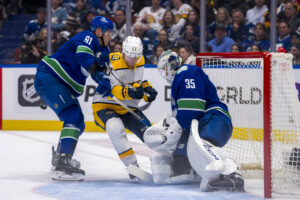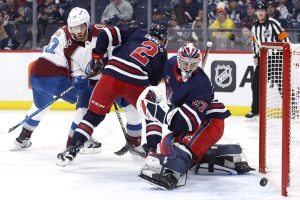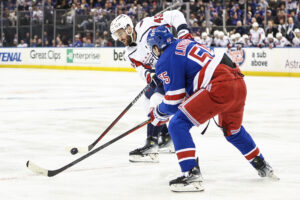“The Vancouver Canucks All-Name Team? How desperate for hockey news are you?”
There are two options here: unseemly speculation about the future or poking around in the past. And at least the past isn’t a moving target. The speculation we’ll get to later. For now, let’s have some fun looking at their history.
Vancouver Canucks All-Name Team
Behind the Bench
Bill LaForge
What could be a better name for someone who is trying to build a team? Alas, the flame that burns hottest burns briefest. Well, maybe “hottest” isn’t the best term to use here…
If there was a coach who exemplified Reggie Dunlop, it was LaForge. The first OHL game he coached had five fights and two line brawls. He got the unheralded Oshawa Generals to the playoffs, which was impressive. He also got into another brawl, this time pre-game, and received a 50-game suspension.
LaForge jumped leagues the next year, coaching the Regina Pats in the WHL. And, coincidentally, avoiding the 50-game suspension handed down by the OHL. The Pats finished the year with twenty line brawls (two in the pre-season) and five fifty-goal scorers. They made it to the finals before losing that series 4-1… and initiating a brawl after the last game was over.
He jumped teams again, joining the Kamloops Junior Oilers. In his first season, the team improved by 28 wins from their previous year. And had seven brawls and led the division in penalty minutes.
Two years later in 1984-85, he was chosen over Mike Keenan to coach the Vancouver Canucks. His “PhD” mantra (“pride, hustle, desire”) didn’t play as well with professionals as it did with teenagers, and his tenure was brief. In LaForge’s 20 NHL game coaching career, his team was outscored 67-119.
Sure, his 4-14-2 record is the least successful of any Vancouver Canucks coach. And sure, he ran cartoonishly violent teams. But LaForge is more than worthy to run the bench for the Canucks All-Name Team.
Up Front
Treated like Royalty
There is a lost art to naming team lines. The Production Line. The French Connection. Legion of Doom. For the Canucks All-Name Team, most people probably know the West Coast Express. But we’re talking players here, not lines.
The Sedins have been part of two named lines. The first was the short-lived Mattress Line with Jason King (two twins and a king, gettit?) It was the Sedins’ fourth year in the NHL, and they were still finding their way on a strong Canucks team. It’s difficult to picture now, but they were still working with bottom-six ice time. They wouldn’t emerge as a major scoring threat until after the 2004-05 lockout. But the year before? There were signs.
King was a long-shot pick – 212th overall in 2001 from the Halifax Mooseheads. In his final season in junior, he scored 99 points in 61 games. The next year, his first as a pro, he scored 20 goals and 40 points with the Manitoba Moose. That got him a cup of coffee with the Canucks, and he started 2003-04 lining up with the Sedins. Not bad at all for a seventh-round pick.
The trio got off to a roaring start. It was good enough to get King named Rookie of the Month in November 2003. He was even given some of the credit for getting the twins to produce, but it didn’t last and King went back to the AHL halfway through the season. The lockout left him there the next year where he racked up 53 points 59 games. Unfortunately, a serious concussion and an improving Canucks team limited his chances, and he went to Europe shortly after rejecting a qualifying offer. The Mattress line never reformed, and the Sedins formed the Three Brothers line with Anson Carter in 2005-06.
Crystal Clear Play
Tanner Glass was never confused about what would get him into the league. The Canucks were looking for someone to anchor their fourth line with a physical element, and Glass could do exactly that. In his two seasons in Vancouver, he did everything to belie the delicacy of his last name. He never left the fourth line, but he was also the only consistent player there, earning the trust of his coach and team through a rotating cast at the bottom of the Canucks lineup. A low-skill player when they were being phased out of the league, he was still valued for his leadership.
Glass played 140 regular-season games with the Canucks, more than any other team during his eleven-year career, getting seven goals, 21 points and 187 penalty minutes. In the playoffs, it was much the same story, getting no points and 18 penalty minutes in 24 games.
Seek and Destroy
Speaking of players whose style has fallen out of favour: Tim Hunter.
Hunter wasn’t just a tough guy in the Eighties, he was one of the best. And most active, leading the league in penalty minutes twice while he was with the Calgary Flames. But one of those years included a Stanley Cup ring. That always gets the attention of teams that don’t yet have one. The tricky thing about that for Vancouver was Hunter being a Public Enemy: he fought against Vancouver a dozen times. Some of those battles were in the playoffs, which is always more memorable. But the Canucks wanted his toughness, his experience, and his Cup ring.
They do say absence makes the heart grow fonder, so when Hunter was claimed by the Tampa Bay Lightning and flipped to the Quebec Nordiques, it was just a matter of time. As soon as he 104-point Nordiques realized they had no room for him, the Canucks snapped him off waivers. Vancouver was a 101-point team that year, but… different priorities? Whatever the reason, he stayed a Canucks for 176 regular-season games and another 46 in the playoffs, including a Stanley Cup Final run in 1993-94.
The Blue Line
A Cutting Wit
Bill LaForge got to coach his Regina Pats captain – they of the 18 regular-season line brawls – in the NHL. Fortunately for the Canucks, Garth Butcher‘s career lasted far, far longer. Butcher’s last two full seasons in junior saw him score 33 goals, 178 points… and 548 minutes in penalties. So you can see why LaForge liked him.
The scoring didn’t follow him into the NHL, but the penalties certainly did. Not that he was completely ineffective, getting 33 goals in 140 points in 610 games with the Canucks. But it’s not really what he was drafted for. He lived up to his name, getting 1668 penalty minutes in his 10 years in Vancouver. He was a gleeful enforcer, and one of the best chirpers in the league. (To Stu Grimson: “Why are you called Stu? Your parents couldn’t spell stupid?”) His name is a natural fit for the Canucks All-Name team. And if there’s any player who looks the part, it’s Garth Butcher.
Secondary Claws
Canucks fans are a hard-luck bunch. Their team has come within one won of the Stanley Cup – twice – never winning it. Cap rules were retroactively changed to punish them for the Roberto Luongo contract. They’ve never moved up in 25 years of the lottery draft. This wouldn’t be too bad if they didn’t also drop in each of the last four years.
But those draft losses are arguably the oldest tradition the Canucks have.
When they entered the league with expansion cousin Buffalo Sabres, they had to split the talent available. The winner of the spinning roulette wheel (yup) would get to pick All-Star Gilbert Perreault. Then-NHL President Clarence Campbell called out the wrong number, and Vancouver celebrated! It was a great start for a few seconds, anyway. They’d have to wait thirty years to draft a 1,000 point player (or two) instead of getting him on Day One.
So the Canucks had to make do with the perfectly good Dale Tallon. In his first year, Tallon finished fifth in Calder voting and racked up 56 points in 78 games. Or less than half what Bobby Orr scored that year. Still, no pressure.
Tallon was on a horrible team, and his penalty minutes increased as his points dropped. He was traded away after 222 games, ending his time in Vancouver with 44 goals and 1137 points. And, of course, a name that’s worthy of 219 minutes in penalties and a spot on the Canucks All-Name Team.
Net Presence
Ask a team what they want in a goaltender, and “stability” is one of the first words you’ll hear. Synonyms abound. Reliable. Solid. That’s what you’re looking for in the goaltender of the Canucks’ All-Name Team, right?
Enter Troy Gamble.
Gamble was drafted 25th overall in 1985 – two spots ahead of “Joe Alphabet” – after a promising start in Medicine Hat. He got a cup of coffee straight out of junior in the 1986-87 season in an emergency call-up. That was a risky move (say hi, Michael DiPietro!) and he got burned for four goals and the loss. He finished up his junior career and got a bit of seasoning in the minors before his next NHL run two years later. In those five games, he managed just two wins but a sparkling .913 SV%.
On the strength of that showing, the Canucks sent Gamble back to lead their IHL. There, he… didn’t do so well. An .870 SV% and goals against of 4.21 didn’t augur well. Still, maybe he’s one of those guys who do better at the NHL level than in the minors. Sure, that’s a thing.
In his first full season with the Canucks, Gamble went 16-16-6 with an .879 SV% and 3.45 goals against average. Still, he out-duelled this other kid he was sharing the net with, some “Kirk McLean” guy. That same guy who became one of the best goaltenders in the league the next year and effectively ended Gamble’s career. But he was a starting goaltender in the NHL for one season, which is a long shot he hit.
Honourable Mention(s)
The Canucks had a pretty good track record with brothers in the 21st century. They decided to see if their AHL affiliate could have similar luck, signing Lee Sweatt and Bill Sweatt in 2010. The brothers won the world roller hockey championship together in 2006 – another good sign, given the team’s last roller hockey signee. The promise to have the brothers play together was enough to bring Lee back from Europe when brother Bill graduated from Colorado College.
Another Brother Act
Lee was a small, skilled defenceman and did fairly well in Manitoba, getting five goals and fourteen points in 41 games. He did get a three-game call-up, with one goal and one assist to show for it. That is the sum of his NHL career, and he was unsigned by Vancouver at the end of the year. Lee signed on with the Ottawa Senators as a free agent, but when it looked like he was going to be back in the AHL he decided instead to retire. It’s great that his skills took him to Europe, but he wanted to build a career. Odds are good he made a lot more money in finances than he would have as a professional hockey player.
The younger Bill went the opposite direction with his career. He signed on with Vancouver directly from college, joining Lee in Manitoba. He had been drafted by the Chicago Blackhawks in 2007 and traded to the Toronto Maple Leafs, but never signed. Bill was larger than Lee, and a forward, but he played much the same way. The brothers relied on smart play and good positioning, and Bill was effective as depth scoring for the Moose. He had a three-year deal, but only got three games in the NHL in that time. He eventually spent five years in the SHL before retiring from hockey.
Six games total pushed the Sweatt brothers off the Canucks All-Time Name Team, but they should get a mention. Never mind the potential headlines, just think of all the possible goal songs!
Main Photo:






